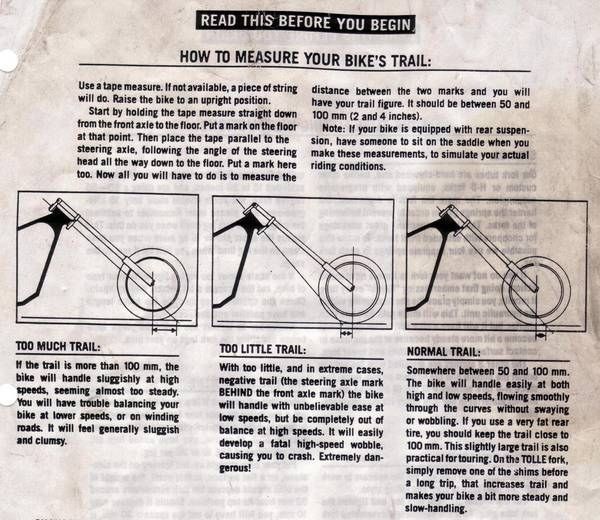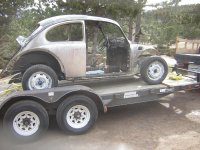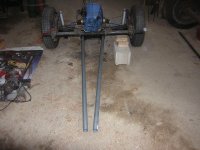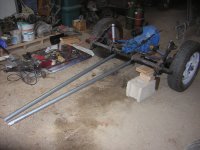I'm getting a lot of variables as far as rake is concerned for VW trikes. I know a rake under 40 is probably going to wobble or drive crappy. I was set on a 43 degree rake before doing some research. now I'm seeing 55 degree rakes that folks are saying drive like a dream. Is there a rake on a VW trike that is proven to be the best overall rake? Not sure what to believe.
Navigation
Install the app
How to install the app on iOS
Follow along with the video below to see how to install our site as a web app on your home screen.
Note: This feature may not be available in some browsers.
More options
You are using an out of date browser. It may not display this or other websites correctly.
You should upgrade or use an alternative browser.
You should upgrade or use an alternative browser.
RAKE
- Thread starter vwbuild
- Start date
DeathBySnuSnu
Old Redneck Motorhead
Well.... It really is not all about rake.
The main thing is trail.
You can make just about any rake angle work. You just have to do the math and make the numbers work.
The main thing is trail.
You can make just about any rake angle work. You just have to do the math and make the numbers work.
Agreed. Trail is more important.
I run a little over 42 degree rake with 1.75" trail. Handles great.
I run a little over 42 degree rake with 1.75" trail. Handles great.
I don't know what the rake on mine is but the trail is around 2'' give or take a little if I remember correctly. It has air forks on it and air shocks on the back so there is a certain amount of adjustment build in. When I first got it running it had a slight low speed wobble so I installed a VW bug steering damper on it and that fixed it right up, rides smooth with no wobble at all. Tire air pressure makes a difference on mine also, I found it rides and steers better if I run the air pressure on the low side. The front end is from a Suzuki GS 850 with the stock 19" rim. It all worked out well.
There's a lot of information out there about rake and trail , seems as though 2 inches of trail works best for everyone . If you use a springer or leading link it can be adjusted at the rockers ,,a telescopic front will be at the triple trees and should be part of the build .
I changed mine a little by changing front wheel size and going to a smaller 16 from a 21 which I wanted the lower fat look in front . I think the reason for most none telescopic forks on these trikes is to get the rake and trail without having to build special triple trees . It would be way easier to change rockers or bells than it would triple trees .
Get on the web and look at some Sugar Bears springer front ends and you can see the wild rockers he uses , it doesn't have to be the norm just work .ThumbUp
I changed mine a little by changing front wheel size and going to a smaller 16 from a 21 which I wanted the lower fat look in front . I think the reason for most none telescopic forks on these trikes is to get the rake and trail without having to build special triple trees . It would be way easier to change rockers or bells than it would triple trees .
Get on the web and look at some Sugar Bears springer front ends and you can see the wild rockers he uses , it doesn't have to be the norm just work .ThumbUp
Loner
VW Tech Expert
Aforementions are for the most part correct, trail is the primary measurement. A couple of other lessons learned from my trike building (45+ years):
1. Rake under 40 degrees is no more or less likely to handle poorer than taller rakes (again, it's mostly in the trail figures).
2. Somewhere in the 37-39 degrees rake area, hydraulic front forks quit working. The road forces loose enough resistance at higher angles to compress, so the forks will just flex. Hard ride, diminished handling.
3. Higher rakes put higher stress on the frame neck, so make sure it is absolutely strong (no matter what rake you use).
4. Lower frame tube(s) (from neck downward) will experience concentrated stress (possibly resulting in flex) approximately 3-5" below the neck joint, so make sure that region is strengthened (with conventional DOM tubing, a brace from the frame backbone to the bottom of the neck will usually dissipate that as well as absorb stress to the backbone).
5. There is no absolute 'best' rake and trail, and as a neat fact there are a minimum of about eight variables that need to be known about a specific trike to project a 'starting point' optimal configuration. And those don't guarantee that the numbers will match owner's ideas/desires as to what he/she would like the overall looks to be.
That said, have fun!!! Remember (as you obviously do) that a good trike must be engineered first and fabricated second - and then be prepared to tweak after some prelimnary testing. Been there, done that with hundreds of trikes on the road.
But its all pure fun!!
1. Rake under 40 degrees is no more or less likely to handle poorer than taller rakes (again, it's mostly in the trail figures).
2. Somewhere in the 37-39 degrees rake area, hydraulic front forks quit working. The road forces loose enough resistance at higher angles to compress, so the forks will just flex. Hard ride, diminished handling.
3. Higher rakes put higher stress on the frame neck, so make sure it is absolutely strong (no matter what rake you use).
4. Lower frame tube(s) (from neck downward) will experience concentrated stress (possibly resulting in flex) approximately 3-5" below the neck joint, so make sure that region is strengthened (with conventional DOM tubing, a brace from the frame backbone to the bottom of the neck will usually dissipate that as well as absorb stress to the backbone).
5. There is no absolute 'best' rake and trail, and as a neat fact there are a minimum of about eight variables that need to be known about a specific trike to project a 'starting point' optimal configuration. And those don't guarantee that the numbers will match owner's ideas/desires as to what he/she would like the overall looks to be.
That said, have fun!!! Remember (as you obviously do) that a good trike must be engineered first and fabricated second - and then be prepared to tweak after some prelimnary testing. Been there, done that with hundreds of trikes on the road.
But its all pure fun!!
skuuter
10000+ Posts
Yep, 2" of Trail seems to be the "Magic Starting Point Number" for "Most" Trike Set-ups....All the Various Ones I've ridden, regardless of Brand that have this or just slightly above or below this number seem to handle and track well......GOOD LUCK on Your Rake/Trail Quest.....Great Bunch of Informative Posts contributed here.....THANKS Folks.....ThumbUp
DeathBySnuSnu
Old Redneck Motorhead
- Thread starter
- #9
Everyone has sure been helpful here. Hope others can learn from peoples responses also. I decided to use a girder unless a reasonably priced springer come up from somewhere. Still the girder seems to be stronger where it needs to be. Tried to layout a frame build last night using 2x4 boards. A local Craigslist add has an girder for sale but not sure it will fit. I see that a neck for a Harley will take Harley bearings and a Honda will need a Honda Neck with different bearings.
I was thinking if a guy had a square neck (outside) it would be easier to weld to a frame that had rectangle tubing. Tried finding a site that explains measurement for a girder and that is difficult also. My question now is how tall is the frame where the fork neck attaches. This probably varies alot. I see there are extensions for handlebars made for up and down adjustment. Any suggestions on manufacturer of a girder and what to look for? Thanks again for all the help here.
I was thinking if a guy had a square neck (outside) it would be easier to weld to a frame that had rectangle tubing. Tried finding a site that explains measurement for a girder and that is difficult also. My question now is how tall is the frame where the fork neck attaches. This probably varies alot. I see there are extensions for handlebars made for up and down adjustment. Any suggestions on manufacturer of a girder and what to look for? Thanks again for all the help here.
DeathBySnuSnu
Old Redneck Motorhead
Ok... so as long as the trail is good just about anything is rideable. You may want more or less rake or more or less neck height for your specific purpose.
For instance a crotch rocket has a low neck and little rake. It handles quick and nimble but can also be quite twitchy at high speed. Not really a beginner bike.
Then at the other extreme is a cruiser, long slower to turn, very stable and straight ahead at speed. Blow down the highway with very little rider input.
When I build I do it to my personal preference. I have an idea what I want it to look like and what I want to do with it. My tricycle is 40 degree out from vertical ( some rake but not so much). The neck is low ( i can measure it if you want). And the forks are short and stiff. So basically mine is a sporty run about not a highway cruiser.
Look around and get an idea of what you want it to look like, what will fit your body type, and the purpose you intend for the bike.
You can make the numbers work for just about anything, the basic geometry is the same for all the suspension types. With a girder or a spirder the dynamics of what happens during the travel will need to be considered. For instance does the trail get longer or shorter as the suspension moves.
Do you need info on how to build a girder?
For instance a crotch rocket has a low neck and little rake. It handles quick and nimble but can also be quite twitchy at high speed. Not really a beginner bike.
Then at the other extreme is a cruiser, long slower to turn, very stable and straight ahead at speed. Blow down the highway with very little rider input.
When I build I do it to my personal preference. I have an idea what I want it to look like and what I want to do with it. My tricycle is 40 degree out from vertical ( some rake but not so much). The neck is low ( i can measure it if you want). And the forks are short and stiff. So basically mine is a sporty run about not a highway cruiser.
Look around and get an idea of what you want it to look like, what will fit your body type, and the purpose you intend for the bike.
You can make the numbers work for just about anything, the basic geometry is the same for all the suspension types. With a girder or a spirder the dynamics of what happens during the travel will need to be considered. For instance does the trail get longer or shorter as the suspension moves.
Do you need info on how to build a girder?
- Thread starter
- #11
Ok... so as long as the trail is good just about anything is rideable. You may want more or less rake or more or less neck height for your specific purpose.
For instance a crotch rocket has a low neck and little rake. It handles quick and nimble but can also be quite twitchy at high speed. Not really a beginner bike.
Then at the other extreme is a cruiser, long slower to turn, very stable and straight ahead at speed. Blow down the highway with very little rider input.
When I build I do it to my personal preference. I have an idea what I want it to look like and what I want to do with it. My tricycle is 40 degree out from vertical ( some rake but not so much). The neck is low ( i can measure it if you want). And the forks are short and stiff. So basically mine is a sporty run about not a highway cruiser.
Look around and get an idea of what you want it to look like, what will fit your body type, and the purpose you intend for the bike.
You can make the numbers work for just about anything, the basic geometry is the same for all the suspension types. With a girder or a spirder the dynamics of what happens during the travel will need to be considered. For instance does the trail get longer or shorter as the suspension moves.
Do you need info on how to build a girder?
Thanks for this. I live away from town so am looking to build a VW trike cruiser. All highway. I'm using an old car seat to kinda get an idea as to neck height but am thinking I should order some seats that sit lower before moving on. Seems like every step in a build is filled with questions. I need a seat that lays back. Had 6 surgeries so far including on my back. Checked with Summitt Racing--can't really tell what would be comfortable. And the height is difficult to judge. Guess that's why people build their own seats. The height of my floor (tube) appears to be around 13-1/4". This is with 25-1/2" tires.
I want 28" to 30" tires eventually so the frame that goes under the seat will be higher off the ground. I couldn't begin to tell you what I would need in a gerder. You must build these from scratch huh? Oh yea--I'm also contemplating cutting the tunnel in front of the vin number so that would stay on the trike. This would change the height of the floor considerably. I have never cut the tunnel on a beetle and have no idea what to expect when I do. I see some people mount a flat plate vertically on the tunnel after it is cut and weld their tubing to the plate. Lot's of stuff to consider. Thanks again
DeathBySnuSnu
Old Redneck Motorhead
You need to check you local laws and find out how they will want it titled and registered.
I am in a small town in the deep south. All they want is a vin on the neck. It will register as whatever the # goes to. Mine is a gold wing. Some places make you get a new contruction title and issue a new vin. Some places do not allow homebuilds at all.
You more than likely will not need to keep the car vin, but will need to keep a record of it to show where it came from (unless you live where i do).
Mine is completely tubing and has none of the car frame/springs/arms at all. Most of mine is either mounted backwards and or upside down. So like I said.... build to your taste.
A lot of folks build a leading link front end. It seems to be the most simple way to get the numbers to fit together and is also not a too complicated build.
I am in a small town in the deep south. All they want is a vin on the neck. It will register as whatever the # goes to. Mine is a gold wing. Some places make you get a new contruction title and issue a new vin. Some places do not allow homebuilds at all.
You more than likely will not need to keep the car vin, but will need to keep a record of it to show where it came from (unless you live where i do).
Mine is completely tubing and has none of the car frame/springs/arms at all. Most of mine is either mounted backwards and or upside down. So like I said.... build to your taste.
A lot of folks build a leading link front end. It seems to be the most simple way to get the numbers to fit together and is also not a too complicated build.
- Thread starter
- #13
You need to check you local laws and find out how they will want it titled and registered.
I am in a small town in the deep south. All they want is a vin on the neck. It will register as whatever the # goes to. Mine is a gold wing. Some places make you get a new contruction title and issue a new vin. Some places do not allow homebuilds at all.
You more than likely will not need to keep the car vin, but will need to keep a record of it to show where it came from (unless you live where i do).
Mine is completely tubing and has none of the car frame/springs/arms at all. Most of mine is either mounted backwards and or upside down. So like I said.... build to your taste.
A lot of folks build a leading link front end. It seems to be the most simple way to get the numbers to fit together and is also not a too complicated build.
There's another term I've never heard of--Leading link. I'll need to research that one. I called the Colorado Highway patrol here and the guy that inspects trailers etc for vin numbers said. We don't care what you build and we don't care if it falls apart going down the highway. All we check for are lights and brake lights. He said to get the Beetle into my name though. The hell of it is, when I put the Beetle in my name then I need to carry minimum car insurance on it even though it is in pieces. Shitty law here in Colorado.
I have a 1988 Toyota I haven't driven in 10 years. Same thing. Doesn't matter if it's a project you need to carry insurance if you want to keep the license plate current. If you let the license plate lapse, they fine you up to $100.00 to renew it again if they haven't archived the vin and can even find it again. Hope you have better laws out your way. If you can, fill me in on leading link. I'm fart'n around with my mock-up frame right now. I have a car seat in front for driver and an old CJ7 rear seat behind that. Gonna be a long one. Maybe take some pics for here along with my Beetle tear down this weekend.
DeathBySnuSnu
Old Redneck Motorhead
- Thread starter
- #15
I was just reading about rake and trail and I notice motorcycles (2 wheel style) have 3" to 5" or so trails. Wonder why they are different than the 2" trails recommended here for trikes?
DeathBySnuSnu
Old Redneck Motorhead
Trikes typically don't lean.
When it don't lean it needs trail more like a car.
When it don't lean it needs trail more like a car.
Thanks for this. I live away from town so am looking to build a VW trike cruiser. All highway. I'm using an old car seat to kinda get an idea as to neck height but am thinking I should order some seats that sit lower before moving on. Seems like every step in a build is filled with questions. I need a seat that lays back. Had 6 surgeries so far including on my back. Checked with Summitt Racing--can't really tell what would be comfortable. And the height is difficult to judge. Guess that's why people build their own seats. The height of my floor (tube) appears to be around 13-1/4". This is with 25-1/2" tires.
I want 28" to 30" tires eventually so the frame that goes under the seat will be higher off the ground. I couldn't begin to tell you what I would need in a gerder. You must build these from scratch huh? Oh yea--I'm also contemplating cutting the tunnel in front of the vin number so that would stay on the trike. This would change the height of the floor considerably. I have never cut the tunnel on a beetle and have no idea what to expect when I do. I see some people mount a flat plate vertically on the tunnel after it is cut and weld their tubing to the plate. Lot's of stuff to consider. Thanks again
The shift rod, the clutch cable, the fuel line and the accelerator cable all run through the tunnel. If the tunnel is cut off you would have to deal with those things. The tunnel gives the VW it's strength, it's the backbone of the car. The floor pans and the heater channels kind of just hang off of the tunnel although they do add some strength. I've seen VWs with totally rusted floor pans and heater channels still being driven.
If you keep the tunnel as I did then the seat will have to sit on top of it but on mine it worked out to be a good height even with the 30" diameter rear tires. I used a seat from VW Vanagon but nearly any seat would work. Mine slides up and back and reclines just like any car seat. But heck, there are a about a million other ways to build a trike. I built mine so I could sit on it all day and be comfortable, I'm too old to sit on a motorcycle seat all day, I did that when I was younger.:laugh:
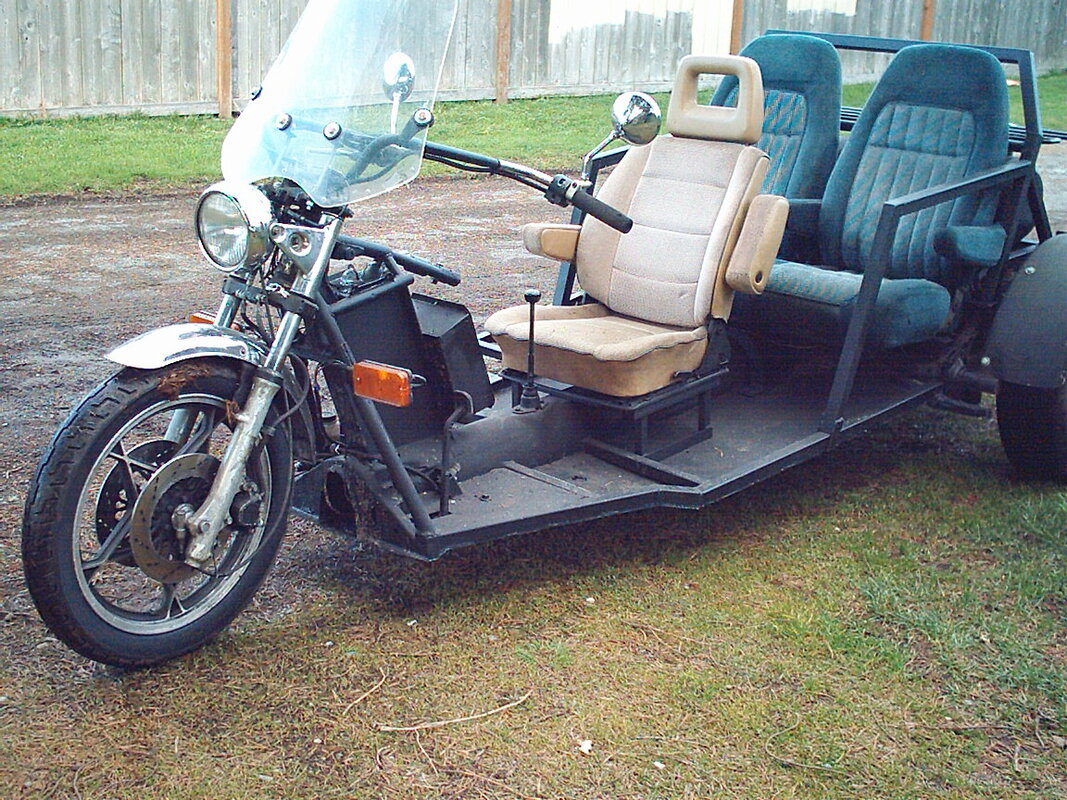
- Thread starter
- #18
My first intentions were to leave part of the tunnel on--especially where the vin number is under the rear seat. I thought it would be a good idea to leave the shifter intact right where it is. So much for the tunnel--it's now gone. if I can figure out how tom attach a pic or two here I will send my build along. Thanks for your input. If I get these pics to load, can anyone tell me if they thought about a frame that pertrudes out of the rear axle assembly in this fashion? Thanks
Attachments
- Thread starter
- #19
I got a few pics to download here (ABOVE). The tubes sticking out are 1-5/8" tube O.D. that I picked up at Home Depot. These are fence posts actually. They went in 12" or so and could be welded in. Of course I'm going to use chromoly eventually and maybe try using 1-3/4" O.D. if I can find something this size. The pipe lean downward toward the front of trike frame so that's a concern. I'm thinking that a plate could be built to cover hole and add support the plate could also be for attaching more frame material. Any opinions out there?
DeathBySnuSnu
Old Redneck Motorhead
DOM tubing is the easiest and most common to use. It is mild steel. Chrome moly is not required for a plain application like this.
Steel (not iron) water pipe, EW (electric weld) tubing and DOM tubing are all plain carbon steel. Steel pipe is not very uniform in wall thickness and quality. EW tubing is much more dimensionally correct and better. Both of these have a weld seam to work around. You must turn the weld seam (visible inside the pipe or ew) to the inside of the bend and also watch which way the load forces will be. It can be done and used to be the only thing available to work with back in the day. Lots of welds, support plugs in the splices and fitting and grinding.
Now there is DOM (drawn over mandrel).
It is the same as EW but as the name implies it has been drawn. The weld is worked in and normalized. You now don't have to clock seams or even pay attention to the physical properties of the pipe/tubing anymore. You can just pick it up and start bending compound bends every which a way.
Square tubing is strong until you have to bend it. So for the most part it will need to be a lot of straight pieces instead of bends.
Many a trike has been built using the original vw design concept. Replace the tunnel with a large piece of square tube cut and angled up to the neck. Then add on running boards.
Just a thought.
Steel (not iron) water pipe, EW (electric weld) tubing and DOM tubing are all plain carbon steel. Steel pipe is not very uniform in wall thickness and quality. EW tubing is much more dimensionally correct and better. Both of these have a weld seam to work around. You must turn the weld seam (visible inside the pipe or ew) to the inside of the bend and also watch which way the load forces will be. It can be done and used to be the only thing available to work with back in the day. Lots of welds, support plugs in the splices and fitting and grinding.
Now there is DOM (drawn over mandrel).
It is the same as EW but as the name implies it has been drawn. The weld is worked in and normalized. You now don't have to clock seams or even pay attention to the physical properties of the pipe/tubing anymore. You can just pick it up and start bending compound bends every which a way.
Square tubing is strong until you have to bend it. So for the most part it will need to be a lot of straight pieces instead of bends.
Many a trike has been built using the original vw design concept. Replace the tunnel with a large piece of square tube cut and angled up to the neck. Then add on running boards.
Just a thought.
Welcome to the Trike Talk Community
Join our vibrant online community dedicated to all things Trikes! Whether you're a seasoned rider or just starting out, this is the place to share experiences, tips, and stories about your three-wheeled adventures. Explore modifications, maintenance advice, and rides, all while connecting with fellow trike enthusiasts from around the globe
Forum statistics
Trike Talk Community
Welcome to a community dedicated to the most diverse and fastest growing powersports segment, Motorcycle Trikes. Come join the discussion about the best makes and models, popular modifications and proven performance hacks, trike touring and travel, maintenance, meetups and more!
Register Already a member? LoginForum statistics







